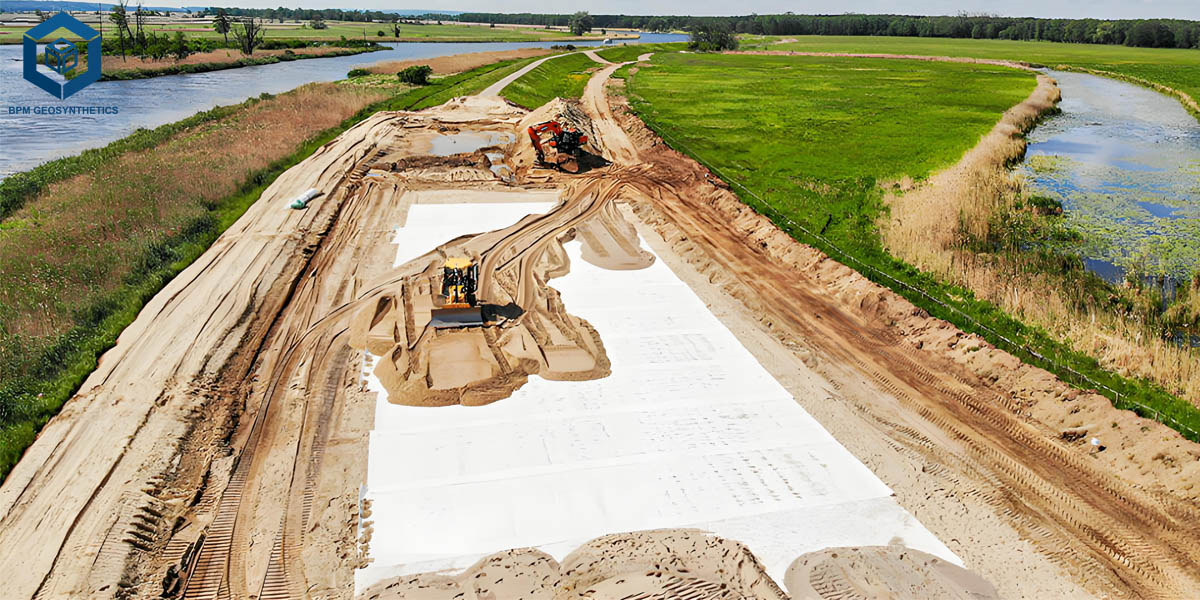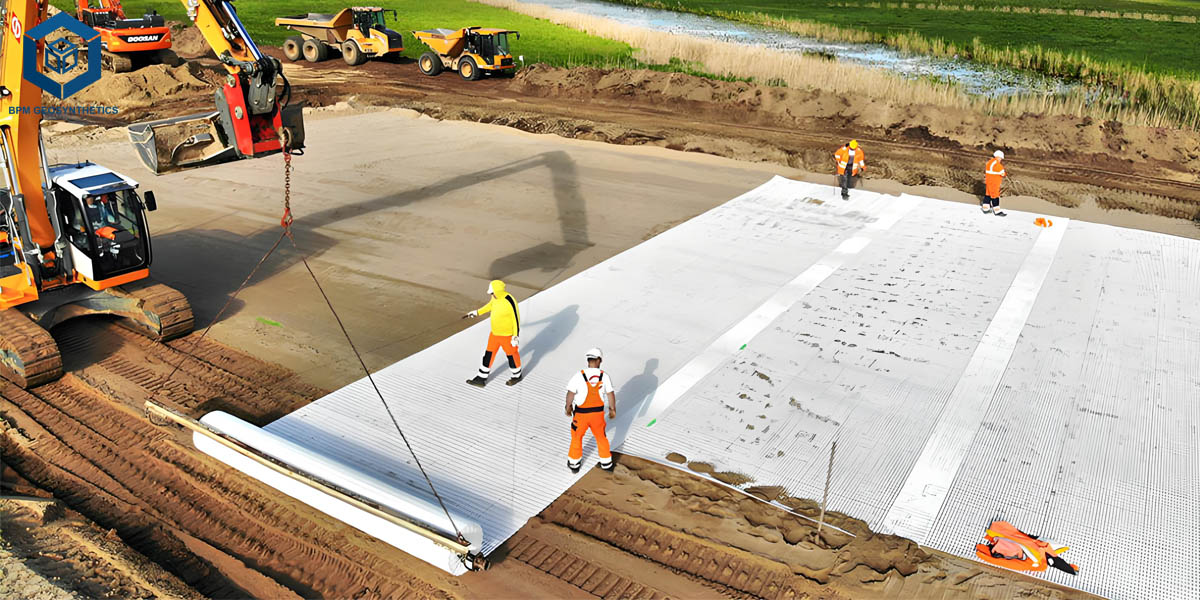What is Non Woven Geotextile Membrane And its Applications?
Non Woven Geotextile Membrane have become a versatile and indispensable material in civil engineering, environmental protection, and infrastructure construction. Unlike traditional woven fabrics, nonwoven geotextiles geomembrane are manufactured using a nonwoven process, where fibers are bonded together mechanically, thermally, or chemically, without the need for weaving or knitting. This unique production method imparts unique physical and functional properties to nonwoven geotextiles membrane, making them suitable for a wide range of practical applications across multiple industries.
1. What is Non Woven Geotextile Membrane?
Nonwoven geotextile membrane is a synthetic or natural fiber-based textile material engineered specifically for geotechnical and civil engineering purposes. Its core defining feature lies in its fiber-bonded structure, which is created using three primary manufacturing techniques:
1.1 Mechanical bonding
Fibers are entangled via needle-punching (the most common method) or hydroentanglement, where high-pressure water jets interlock fibers to form a stable web.
1.2 Thermal bonding
Heat is applied to melt thermoplastic fibers (e.g., polypropylene, polyester) at their intersection points, fusing them together as they cool.
1.3 Chemical bonding
Adhesives or resins are used to bind fibers, though this method is less common due to potential environmental concerns and reduced durability.
The choice of non woven membrane material further shapes its performance. Synthetic fibers—such as polypropylene (PP), polyester (PET), and polyethylene (PE)—dominate the market because of their exceptional resistance to UV radiation, chemical corrosion, and biological degradation. Natural fibers like jute or coir are occasionally used for temporary applications (e.g., erosion control in ecological restoration) but lack the long-term durability of synthetics.
Key characteristics of non woven geotextile include high permeability (allowing water to flow through while retaining solids), excellent tensile strength (resisting stretching under load), good filtration efficiency, and flexibility—all of which make it ideal for addressing geotechnical challenges like soil stabilization, drainage, and erosion prevention.
2. Key Functions of Non Woven Geotextile Membrane
Non-woven geotextiles membrane serve five primary roles in construction and environmental management:
2.1 Separation
Geotextile fabric act as a barrier between dissimilar soil layers (e.g., subgrade and aggregate), preventing intermixing that could weaken structural integrity. For example, in road construction, separation layers reduce rutting by 15–20% and extend pavement lifespan by 20–30% .
2.2 Filtration
By allowing water to pass while retaining soil particles, these geotextile cloth prevent clogging in drainage systems. A 300 GSM (grams per square meter) geotextile membrane can filter 95% of fine sediments, maintaining 99.9% seepage prevention in landfills .
2.3 Reinforcement
They enhance soil stability by distributing loads evenly. In embankments or soft ground, fabric geotextile reduce settlement by redistributing stress, improving load-bearing capacity by up to 30% .
2.4 Drainage
These non woven geotextile fabric facilitate rapid water drainage, reducing hydrostatic pressure by 25–30%. For instance, a 400 GSM membrane in a French drain handles 100–200 L/m²/day of leachate, critical in coastal defense and flood-prone regions .
2.5 Erosion Control
By stabilizing soil and directing water flow, geo fabric reduce erosion by up to 80% on slopes and shorelines
3. Key Applications of Non Woven Geotextile Membrane
3.1 Non Woven Geotextile Membrane for Road and Pavement Construction
3.1.1 Soil Separation
Geotech fabric act as a barrier between subgrade soils and combination layers. This prevents illness of the subgrade, retaining the pavement shape integrity. In highways, this reduces upkeep prices by way of an estimated 15%, prolonging the lifespan of the road.
3.1.2 Drainage Systems
Used in permeable pavements, soakaways, and roadside drainage channels, these non woven geotextile efficaciously control water runoff. For example, a Texas toll road task protecting 50,000 m² established a 25% enchancment in drainage efficiency, saving $500,000 in preservation and restore charges over 5 years. The non woven landscape fabric layer filters exceptional particles whilst permitting water to pass, lowering clogging and extending provider life.
3.1.3 Load Distribution
By imparting uniform stress distribution, woven geotextile fabric minimize rutting and pavement deformation beneath heavy visitors loads. This is specifically integral for highways with heavy truck traffic, the place load-induced differential agreement can be a foremost problem.
3.2 Non Woven Geotextile Membrane for Landfills and Environmental Containment
3.2.1 Leachate Management
Geotextile drainage is regularly paired with HDPE geomembranes in landfill liners to forestall leachate leakage. They act as a shielding cushion and filtration layer, lowering leakage through up to 98%, making sure compliance with EPA and EU environmental standards.
3.2.2 Erosion Control
Slopes and embankments in landfill web sites are included from soil erosion by using stabilizing the floor and directing water flow. Studies exhibit a discount of up to 95% in erosion injury when geotextile filter cloth is applied, stopping sediment loss and retaining slope stability.
3.2.3 Environmental Protection
Geotextile drainage fabric assist include hazardous waste, forestall soil contamination, and aid vegetation boom on landfill covers. This twin characteristic enhances landfill sustainability and reduces long-term environmental impact.
3.3 Non Woven Geotextile Membrane for Hydraulic Engineering
3.3.1 Riverbanks and Canals
Geotextile filter fabric beef up riverbanks, canal sides, and embankments. Their filtration houses permit water to omit whilst conserving soil particles, mitigating erosion with the aid of up to 70%. Root structures combine with the geo fabric cloth, improving long-term slope stability.
3.3.2 Retention Ponds and Stormwater Management
Film geotextile stop nice soil particles from clogging drainage layers in retention ponds, making sure environment friendly water treatment. By retaining permeability, they aid sediment manage and limit protection frequency.
3.3.3 Flood Control Applications
Geo cloth in flood channels forestall financial institution scouring throughout excessive waft events. They also act as shielding layers under riprap or different hydraulic constructions to enhance durability.
3.4 Non Woven Geotextile Membrane for Railway Construction
3.4.1 Track Bed Stabilization
Geo fabric material distribute loads, separate tune ballast from the subgrade, and stop fouling. A 15-mile railway mission in China used 200 GSM polyester filament geotextiles, which decreased differential agreement by means of 80%, substantially enhancing music stability. The software prolonged pavement and tune existence with the aid of 20–30 years and decreased renovation intervals.
3.4.2 Drainage Support
Geotextiles stop water accumulation beneath tracks, making sure drainage layers continue to be functional. This reduces ballast degradation and prolongs the lifestyles of the railway foundation.
3.5 Non Woven Geotextile Membrane for Airport Infrastructure
3.5.1 Runway Reinforcement
At Leh Airport in India, 200 GSM non-woven geotextiles had been utilized over permafrost soils to stabilize the ground, stopping frost heave and structural deformation. This ensures runway integrity in intense altitudes and temperature variations.
3.5.2 Taxiways and Aprons
Geotextiles assist heavy masses from plane whilst stopping soil mixing, lowering the want for high-priced repairs due to agreement or erosion.
3.5.3 Drainage Improvement
Geotextile membranes are built-in into runway drainage structures to stop water accumulation underneath pavements, retaining a secure and long lasting floor for plane operations.
3.6 Non Woven Geotextile Membrane for Industrial and Commercial Projects
3.6.1 Warehouse Foundations
Woven non woven geotextile distribute heavy equipment loads, decreasing basis cracking and settlement. For instance, a 10,000 m² warehouse in Baran, Rajasthan, used geotextile fabric near me to limit basis cracking by way of 40%, considerably extending carrier life.
3.6.2 Green Roofs
Nonwoven geotextile fabric furnish a filtration and drainage layer below inexperienced roofs, helping vegetation boom whilst stopping soil clogging. They manipulate stormwater efficiently, enhancing city warmth island mitigation and promotion sustainable construction.
3.6.3 Landfill Leachate Collection
Geotextile fabric under gravel stop clogging in drainage layers under waste, making sure non-stop leachate series and treatment. A residential improvement in the Netherlands used geotextile landscape fabric in subsurface drainage structures to stop waterlogging in clay-rich soils, enhancing web page protection and usability.
Conclusion
Non Woven Geotextile Membrane is vital in contemporary civil, industrial, and environmental engineering. They grant soil separation, drainage, reinforcement, and filtration, presenting long-term durability, price savings, and environmental protection. Their adaptability throughout highways, railways, airports, landfills, water projects, and industrial purposes underscores their quintessential function as a cornerstone fabric in sustainable and resilient infrastructure development.
Summary
Non Woven Geotextile Membrane, with their unique combination of permeability, strength, and flexibility, offer versatile solutions for highways, landfills, drainage, mining, and aquaculture. The Best Project Material Co., Ltd.(BPM Geosynthetics), a trusted manufacturer with over 20 years of experience, is committed to producing high-quality geosynthetics with advanced R&D, professional sales, and after-sales support. Certified under ISO9001, ISO14001, ISO45001, and tested by SGS and Intertek, BPM’s 60mil HDPE liners lead the industry in performance and reliability. With innovative, cost-effective, and environmentally responsible products, BPM Geosynthetics is ready to be your partner in building sustainable and resilient infrastructure.
Join BPM Geosynthetics, win our future.






